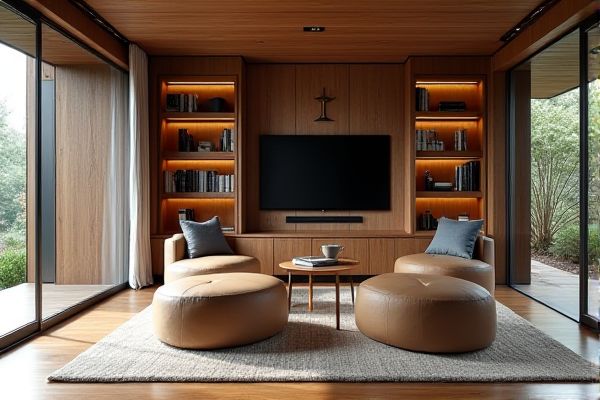
Sliding bookshelves maximize space by allowing shelves to glide horizontally, offering easy access to your collection without requiring extra room, while revolving bookshelves provide a 360-degree rotation, ideal for showcasing books and decorative items in compact areas. Explore the rest of the article to discover which bookshelf style best suits your needs and space.
Table of Comparison
| Feature | Sliding Bookshelf | Revolving Bookshelf |
|---|---|---|
| Design | Horizontal sliding mechanism | Rotating or spinning shelves |
| Space Efficiency | Maximizes wall space, ideal for narrow rooms | Compact footprint, ideal for small spaces |
| Access | Slide to reveal hidden shelves | Rotate entire shelf to access books |
| Capacity | Varies, generally larger storage volume | Limited by revolving mechanism size |
| Installation | Requires track or rail system | Usually freestanding, easy to move |
| Maintenance | Needs track cleaning and lubrication | Minimal, rotating parts need occasional checks |
| Style | Modern and functional | Compact and decorative |
| Price Range | Moderate to high | Low to moderate |
Introduction to Sliding and Revolving Bookshelves
Sliding bookshelves maximize space efficiency by allowing shelves to move horizontally along tracks, perfect for tight rooms or compact home libraries. Revolving bookshelves offer 360-degree access by rotating around a central axis, ideal for showcasing a diverse collection while saving floor space. Your choice depends on whether you prioritize easy access with a modern aesthetic or seamless space-saving functionality.
Design and Aesthetic Differences
Sliding bookshelves offer a sleek, linear design that maximizes wall space while maintaining a minimalist aesthetic, ideal for modern interiors. Revolving bookshelves feature a cylindrical or rotating structure that adds a dynamic, sculptural element, enhancing visual interest and accessibility in compact spaces. The choice between the two depends on desired spatial efficiency and stylistic impact, with sliding units providing streamlined order and revolving models delivering interactive and eye-catching appeal.
Space-Saving Capabilities
Sliding bookshelves maximize space efficiency by utilizing linear movement, allowing access to multiple rows of books within a compact footprint ideal for narrow rooms. Revolving bookshelves offer 360-degree access, making them perfect for small areas where wall space is limited, as they provide multiple storage sides in a vertical, rotating column. Your choice depends on whether you prefer easier access with sliding mechanisms or dynamic, space-saving rotating designs.
Accessibility and Ease of Use
Sliding bookshelves offer enhanced accessibility by allowing you to move entire sections sideways, making it easier to reach books without removing others. Revolving bookshelves rotate around a central axis, providing quick access to multiple sides but may require more physical effort to turn, especially when fully loaded. Your choice depends on whether you prioritize effortless lateral access or space-saving vertical rotation in your storage setup.
Installation and Maintenance
Sliding bookshelves require a sturdy track system for installation, ensuring smooth lateral movement and stable support, while revolving bookshelves need a central pivot and balanced design for proper rotation. Maintenance for sliding bookshelves involves regular cleaning of tracks and lubrication to prevent jams, whereas revolving bookshelves demand occasional tightening of the pivot mechanism and inspection for wobbling. Your choice should consider the ease of installation in your space and the maintenance time you're willing to invest.
Storage Capacity Comparison
Sliding bookshelves typically offer greater storage capacity due to their ability to extend horizontally along a track system, maximizing wall space and allowing for more books or items to be stored in a compact area. Revolving bookshelves, while space-efficient in providing access to multiple shelves within a smaller footprint, usually have limited overall storage capacity because their design prioritizes accessibility and rotation over volume. If your primary goal is maximizing storage for a large collection, a sliding bookshelf may better suit your needs by optimizing available space more effectively.
Safety and Stability Features
Sliding bookshelves incorporate anti-tip mechanisms and reinforced tracks to ensure stable movement and prevent accidental falls. Revolving bookshelves utilize a central pivot with secure locking systems to maintain balance and prevent unintended rotation during use. Both designs prioritize user safety by integrating robust construction materials and stability-enhancing features.
Cost and Budget Considerations
Sliding bookshelves typically require less complex hardware and installation, resulting in lower initial costs compared to revolving bookshelves, which often feature intricate mechanisms and motors that increase the price. Maintenance expenses for revolving bookshelves can be higher due to moving parts that may need regular servicing or repairs. Budget-conscious buyers often prefer sliding bookshelves for their cost-effectiveness and simpler upkeep.
Ideal Use Cases and Room Suitability
Sliding bookshelves excel in narrow or long rooms where space optimization is crucial, ideal for home offices or libraries with limited floor area. Revolving bookshelves suit compact spaces requiring easy access to multiple book categories, making them perfect for living rooms or study nooks. Your choice depends on whether you prioritize linear storage efficiency or quick, all-around book retrieval.
Conclusion: Choosing the Best Bookshelf for Your Needs
Sliding bookshelves optimize space with easy horizontal access, ideal for narrow rooms and maximizing wall storage, while revolving bookshelves offer 360-degree access and a unique aesthetic, perfect for showcasing collections in compact areas. Consider room size, accessibility preferences, and style when selecting between these options to ensure functionality and design harmony. Prioritizing your specific storage needs will help you determine the best bookshelf type for efficient organization and visual appeal.
 homyna.com
homyna.com